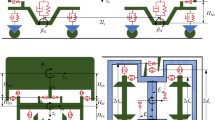Abstract
In this paper, a simplified torsional vibration model of drive system with three degrees of freedom is established, and the elasticity of wheelset is considered. In addition to the same wheel-rail adhesion condition for the two wheels, the different wheel-rail adhesion conditions for the two wheels have been considered for the first time, and the mechanism of the vibration forms is explained from the viewpoint of energy. The nonlinear system is linearized at the origin (equilibrium position), and the critical stability curve of the linearized system is drawn according to the eigenvalues of the linearized system in the state space. The results show that the vibration forms of the system are mainly determined by the relationships between the average creep rate and the critical creep rate of the wheel driven directly by motors. When the resistance moments do positive work on the system, they input energy to the system, and the responses do not tend to the origin and produce self-excited vibration. When the resistance moments do negative work on the system, they dissipate energy to system, and the responses tend to the origin. For the linearized system at the origin, the system is more stable at the origin when following factors occur, a gentler negative slope of the adhesion curve, a faster speed, a lighter wheel load, and a larger the moment of inertia of wheels.
Similar content being viewed by others
References
J. J. Bruwer and G. W. Steinbruegge, Effect of tractive-force variation on rhythmic chassis movements of a wheel-type tractor, Transactions of the ASAE, 5 (2) (1962) 114–115.
T. Hirotsu, S. Kasai and H. Takai, Self-excited vibration during slippage of parallel cardan drives for electric railcars, JSME International Journal, 30 (266) (1987) 1304–1310.
D. F. Wang et al., Stability analysis for self-excited torsional oscillation of vehicle driveline, International Journal of Vehicle Design, 24 (2–3) (2000) 211–223.
J. Z. Jia, X. W. Luo and M. L. Shao, Analysis of the amplitude of the self-excited vibration in vehicle power train and factors influencing the amplitude, Transactions of the CSAE, 14 (3) (1998) 43–47 (in Chinese).
X. X. Zhang and Y. Yao, Modeling and simulation of selfexcited vibration of drive system on locomotive, Electric Locomotives & Mass Transit Vehicles, 31 (6) (2008) 24–27 (in Chinese).
R. Konowrocki and T. Szolc, An analysis of the self-excited torsional vibrations of the electromechanical drive system, Vibrations in Physical System, 27 (2016) 187–194
M. Lata, The modern wheelset drive system and possibilities of modelling the torsion dynamics, Transport, 23 (2) (2008) 172–181.
Z. Gao, Y. Zang and D. Wu, Hopf bifurcation and feedback control of self-excited torsion vibration in the drive system, Noise & Vibration Worldwide, 42 (10) (2011) 68–74.
P. Shi, B. Liu and D. Hou, Torsional vibration suppression of drive system based on DMC method, Proceedings of the 7th World Congress on Intelligent Control and Automation, Chongqing, China (2008) 4789–4792.
L. Z. Zheng, J. Z. Jia and Y. S. Cheng, Research on the self-excited vibration in wheeled vehicle powertrainmechanism analysis of the self-excited vibration, Transactions of the CSAE, 12 (4) (1996) 37–42 (in Chinese).
M. L. Shao, H. Wang, J. C. Wang and L. J. Wang, Study on self-excited vibration in engineering vehicle powertrain, Journal of Tongji University, 29 (12) (2001) 1404–1406 (in Chinese).
A. Crowther, N. Zhang, D. K. Liu and J. K. Jeyakumaran, Analysis and simulation of clutch engagement judder and stick–slip in automotive powertrain systems, Proc Instn Mech. Engrs, Part D: J. Automobile Engineering, 218 (12) (2004) 1427–1446.
S. Y. Ren, J. H. Bao, J. W. Zhang and X. H. Zhong, Modelling and simulation of the self-excited torsional vibration of driveline for SZG 4031 towing tractor under heavy load, Journal of Vibration and Shock, 24 (6) (2005) 95–101 (in Chinese).
Y. Yao, S. Zhao, F. Xiao and J. Liu, The effects of wheelset driving system suspension parameters on the re-adhesion performance of locomotives, Vehicle System Dynamics, 53 (12) (2015) 1935–1951.
Y. Yao, H. Zhang and S. Luo, An analysis of resonance effects in locomotive drive systems experiencing wheel/rail saturation adhesion, Proc. Instn. Mech. Engrs, Part F: J. Rail and Rapid Transit, 228 (1) (2014) 4–15.
J. Liu, H. Zhao and W. Zhai, Mechanism of self-excited torsional vibration of locomotive driving system, Front. Mech. Eng. China, 5 (4) (2010) 465–469.
Y. Yuan, H. Zhang, Y. Li and S. Luo, The dynamic study of locomotives under saturated adhesion, Vehicle System Dynamics, 49 (8) (2011) 1321–1338.
O. Polach, Creep forces in simulations of traction vehicles running on adhesion limit, Wear, 258 (2005) 992–1000
H. K. Khalil, Nonlinear Systems, Third Edition, Prentice Hall Press, Upper Saddle River, New Jersey (2002) 134.
J. Justus, Ecological and Lyapunov stability, Biennial Meeting of the Philosophy of Science Association, Vancouver, Canada (2006) 3–4.
Author information
Authors and Affiliations
Corresponding author
Additional information
Recommended by Associate Editor Sungsoo Na
Kun Xu is a Ph.D. student at State Key Laboratory of Traction Power in Southwest Jiaotong University, People’s Republic of China. His major is specialized in nonlinear dynamics in vehicle system.
Rights and permissions
About this article
Cite this article
Xu, K., Zeng, J. & Wei, L. An analysis of the self-excited torsional vibration of high-speed train drive system. J Mech Sci Technol 33, 1149–1158 (2019). https://doi.org/10.1007/s12206-019-0214-4
Received:
Revised:
Accepted:
Published:
Issue Date:
DOI: https://doi.org/10.1007/s12206-019-0214-4




